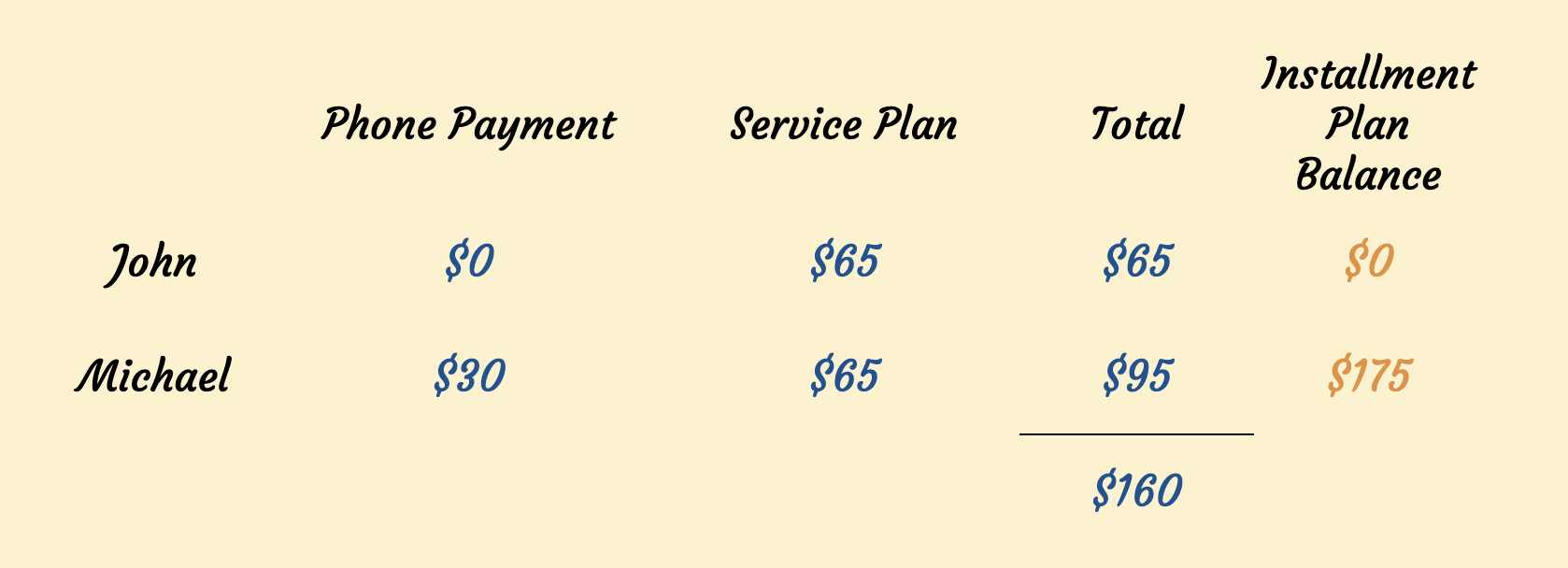
Understanding Your Phone Bill: Spending and Data Usage
Are you spending a lot on your cell phone? Understanding your phone bill will help you see where the money is going and how much you could save by switching to a low-cost carrier.
Phone bills can be challenging to read, but this article will help you cut through the noise to answer three essential questions:
- Do you have a phone installment plan?
- How much are you spending on service?
- How much data do you use?
Why do these questions matter?
A phone installment plan means you make a monthly device payment and have a balance to pay off before you own your phone. One of the first steps to changing carriers is getting rid of your installment plan.
The amount you spend on service helps you calculate how much you can save by switching to a low-cost plan. For example, if you spend $65 a month on service and switch to a cheaper plan that costs $25 a month, you’ll save $40 a month ($480 a year).
Finally, understanding how much data you typically use is essential for choosing the right-sized plan and maximizing your savings.
Open up your latest phone bill, and let’s get started!

Get the e-book
Cell phone service doesn’t have to be expensive! My short e-book will teach you everything you need to know to switch to a low-cost carrier. Learn why the service is just as good and how to find the plan that's right for you. I also teach you how to take control of your phone and get a good deal on your next one!
Do you have a device payment?
Many people have installment plans on their phones. When you get a new phone from your carrier and agree to make monthly payments for 1-3 years, that’s an installment plan.
Check your bill for your monthly installment payment and write that down. Your statement should also show your remaining balance, which you should note. Some wireless carriers might use alternate terminology, like equipment payment or device payment.
You might receive bill credits, where the carrier provides a monthly discount on your device payment, possibly even reducing it to zero. In this case, write down your bottom-line monthly device payment along with your remaining balance.
If you do not have an installment plan, you own your phone. Lucky you! When you’re ready to switch to a low-cost carrier, you’ll still want to ensure your phone is unlocked.
If you have multiple lines of service on your account, determine your device payment and the remaining balance for each phone. You may find that you’re making payments on one phone but not another.
How much are you spending on service?
Your phone bill might look overwhelming: service charges, autopay discounts, taxes, fees, and other line items add to the noise. However, there’s a shortcut to figuring out how much your plan costs.
If you have a single line of service, simply subtract your device payment (if any) from your total bill and write that down: that’s what you’re spending on phone service.
Example: Sarah’s bill is $95 a month. She pays $25 a month on her installment plan ($175 remaining). She subtracts $25 from $95 and determines that she’s spending $70 a month on service.
If you have multiple lines of service, the jumble of charges, discounts, and fees might seem confusing. The simplest thing to do is work out the average price per line. Subtract all device payments from the total bill, then divide the remainder by the number of lines.
Example: John and Michael share a $170 bill from AT&T. John owns his phone. Michael has an installment plan with a $30 monthly device payment ($180 remaining). The bill says John’s service plan costs $80, while Michael’s costs $60 due to a “second-line discount”.
John and Michael subtract the $30 monthly payment from their $160 bill to arrive at $130. To figure out their average service costs, they divide $130 by two to arrive at $65 each.
Check for unusual fees
The approach I describe above simplifies your bill: Bill = Device Payment + Service Plan. However, there are a few types of charges that you should call out separately:
- Insurance or device protection payments
- Irregular fees, such as roaming charges
- Other device payments, such as a smartwatch
- Unrelated services, such as home internet (if that’s bundled with your phone bill)
If you have any uncommon charges or fees, subtract them before working out how much you’re paying for your service plan.
How much data are you using?
Expensive phone plans with AT&T, Verizon, and T-Mobile come with unlimited data. However, your monthly bill will tell you how many gigabytes of data you actually used.
Understanding your data usage is vital to selecting the right-sized low-cost plan. Although some low-cost plans also offer unlimited data, most people will save more by choosing a plan whose data allowance matches their needs.
I recommend you look back over a few months of phone bills to get an accurate picture of your data usage.
Example: John used 5.2 GB of data this month, 6.1 GB last month, and 4.9 GB the month before. John writes down the highest number, 6.1 GB, and will look for a plan that offers that amount of data plus some wiggle room.
If you have multiple lines of service on your bill, figure out the data usage for each phone or device. You may discover that each person on your plan has different data usage. You can often maximize your savings by picking the right-sized plan for each individual rather than lumping everyone onto a more expensive plan.
Good to know: Unlimited talking and texting are nearly universal across all plans, so don’t worry about how many minutes you talk or how many texts you send!
Bottom line
Understanding your phone bill helps you see three things clearly:
- What you owe on your phone.
- What you’re paying for service.
- How much data you use.
With this information, you can take the steps to save money: pay off your phone and switch to the right low-cost plan!


